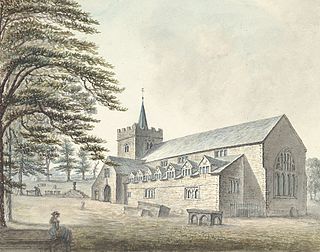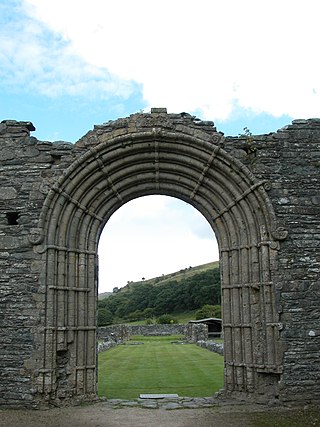This article includes a list of general references, but it lacks sufficient corresponding inline citations .(February 2018) |

Abbey-Cwm-Hir Hall is a neo-Elizabethan country house in the Welsh county of Powys.
This article includes a list of general references, but it lacks sufficient corresponding inline citations .(February 2018) |

Abbey-Cwm-Hir Hall is a neo-Elizabethan country house in the Welsh county of Powys.
The hall was built in 1833 for Thomas Wilson, a London lawyer, on the site of a Tudor style house built c. 1656 for the Fowler family, which was later owned by the Hastings family, Earls of Huntingdon. Wilson purchased the 3000-acre estate and landscaped the grounds, building the hall on a steep south facing slope overlooking the ruined abbey and creating a lake so the village would have water power for the sawmill. Having ruined himself financially in the process he emigrated to Australia, where in 1842 he became Mayor of Adelaide. Eventually the hall and grounds fell into a state of disrepair.
Wilson's house was extended and altered as a Victorian mansion of ashlar, decorated with polychromatic bands and elaborate bargeboards, by Poundley and Walker of Liverpool in 1867–69 for the Philips family. The house was doubled in size in 1869, and they added the snooker room in 1894.
In 1837 Francis Philips (1771–1850) J.P., D.L., of Bank Hall, Heaton Norris, Lancashire, purchased the Abbeycwmhir Estate, which had fallen into a state of disrepair, and did much to improve it. His eldest son and heir, Francis Aspinall Philips (1793–1859), inherited both of his father's estates. Although he lived at Bank Hall, he spent much time at Abbeycwmhir, eventually becoming High Sheriff of Radnorshire. In turn, his eldest son succeeded to Bank Hall and it was Francis' younger son, George Henry Philips (1831–1886) J.P., D.L., of who inherited and lived at Abbeycwmhir. Presumably it was George Henry sculpted the house as it is seen today.
The Philips were an old Staffordshire family who had held manors there since the reign of King Edward VI. Francis Philips' ancestors had been seated at The Heath House in that county since the early seventeenth century, and it is still owned by the Philips family today. In the mid-eighteenth century the family built the Tean Hall Mills and soon became well known as major cotton manufacturers in Manchester. Francis Philips was a first cousin once removed of Sir George Philips, 1st Baronet.
Paul and Victoria Humpherston bought the Hall in late 1997 and have spent the subsequent years restoring it. Their results have been featured on BBC's "Discovering Welsh Houses" and Wales Today, on ITV's Wales Tonight and on S4C.
After several years of being opened for public tours, the house closed permanently to visitors in 2020 due to the Covid pandemic. The gardens are listed, also at Grade II, on the Cadw/ICOMOS Register of Parks and Gardens of Special Historic Interest in Wales. [1]

Radnorshire is one of the thirteen historic counties of Wales and a former administrative county. It covers a sparsely populated area in mid Wales. The historic county was bounded to the north by Montgomeryshire and Shropshire, to the east by Herefordshire, to the south by Brecknockshire and to the west by Cardiganshire.

Powis Castle is a medieval castle, fortress and grand country house near Welshpool, in Powys, Wales. The seat of the Herbert family, earls of Powis, the castle is known for its formal gardens and for its interiors, the former having been described as "the most important", and the latter "the most magnificent", in the country. The castle and gardens are under the care of the National Trust. Powis Castle is a Grade I listed building, while its gardens have their own Grade I listing on the Cadw/ICOMOS Register of Parks and Gardens of Special Historic Interest in Wales.
Berriew is a village and community in Montgomeryshire, Powys, Wales. It is on the Montgomeryshire Canal and the Afon Rhiw, near the confluence with the River Severn at grid reference SJ185005, 79 miles (128 km) from Cardiff and 151 miles (243 km) from London. The village itself had a population of 283. and the community also includes Garthmyl Hall and Refail.
Abbeycwmhir or Abbey Cwmhir is a village and community in the valley of the Nant Clywedog in Radnorshire, Powys, Wales. The community includes the hamlet of Bwlch-y-sarnau.
Staylittle, sometimes referred to colloquially as Y Stay or Y Stae, is a small village set in the shallow upland basin of the Afon Clywedog on the B4518 road, equidistant from Llanidloes and Llanbrynmair in the historic county of Montgomeryshire, Wales, although now administered as part of the unitary authority of Powys.

Plas Machynlleth is the former Welsh residence of the Marquesses of Londonderry. It is situated in the market town of Machynlleth in Powys, Wales. It was brought into the family following the 1846 marriage of the then Viscount Seaham to Mary Cornelia Edwards, who inherited it on the death of her father, Sir John Edwards, in 1850. Sir John had extended and renamed the house. It is a Grade II* listed building and its gardens, now mainly a public park, are listed on the Cadw/ICOMOS Register of Parks and Gardens of Special Historic Interest in Wales.

Cwmhir Abbey, near Llandrindod Wells in Powys, is a Welsh Cistercian monastery founded in 1176 by Cadwallon ap Madog. A spurious tale was later recorded that the abbey was founded in 1143 by Meredudd ap Maelgwn at Ty-faenor, and then refounded at the present location near the village of Abbeycwmhir in 1176. There does appear to be a site movement from Ty-faenor, but Maredudd ap Maelgwn was prince of Maelienydd in 1215 under Prince Llywelyn ab Iorwerth of Gwynedd, who then controlled the district. The later charter to the abbey in 1215 caused the confusion and led to the belief that Maredudd had founded the abbey in 1143.
Thomas Wilson was a solicitor, author and Mayor of Adelaide from 1842 to 1843.

Bacheldre is a small settlement in Powys, Wales. It is near the A489 road and is 5 kilometres (3 mi) southeast of the town of Montgomery.

Leighton Hall is an estate located to the east of Welshpool in the historic county of Montgomeryshire, now Powys, in Wales. Leighton Hall is a listed grade I property. It is located on the opposite side of the valley of the river Severn to Powis Castle. The Leighton Hall Estate is particularly notable for the hall which was decorated and furnished by the Craces to designs by Pugin in his Houses of Parliament style, for the Home Farm, a model farm, which was to be in the forefront of the Victorian industrialised High Farming, and for the gardens which have their own Grade I listing on the Cadw/ICOMOS Register of Parks and Gardens of Special Historic Interest in Wales. Leighton Hall was also the birthplace of the much disparaged hybrid Cupressocyparis leylandii hedge tree. The hall is in private ownership and is not accessible to the public, although it can still be viewed from the road. The home farm is currently under restoration.

The Rhydspence Inn is a 14th-century inn situated on the Wales-England border and within the Wye Valley overlooking the Welsh hills and Herefordshire countryside. According to English Heritage it was built in the 16th century with 19th and late 20th century additions. It is a former gentry house and was not built as an inn. Until well into the sixteenth century droving on any scale in the Marches was far too risky. In such a lonely and lawless area, cattle rustling was rife, often by the authorities themselves. The Land of Speis means simply land of thorn bushes, which it is. The name is still in use today. Abbey Cwm Hir was always a modest house, the monks were predominately Welsh and apart from the Abbey's officers would have little occasion to leave it.
Slebech was a community in Pembrokeshire, Wales, which is now part of the combined community of Uzmaston and Boulston and Slebech, a sparsely populated community on the northern shore of the Eastern River Cleddau. The community shares boundaries with the communities of Wiston and Llawhaden and mainly consists of farmland and woodland. Much of the community is within the Pembrokeshire Coast National Park and Picton Castle's stable block loft is an important breeding roost for the rare Greater Horseshoe Bat.

Valle Crucis Abbey is a Cistercian abbey located in Llantysilio in Denbighshire, Wales. More formally the Abbey Church of the Blessed Virgin Mary, Valle Crucis it is known in Welsh both as Abaty Glyn Egwestl and Abaty Glyn y Groes. The abbey was built in 1201 by Madog ap Gruffydd Maelor, Prince of Powys Fadog. Valle Crucis was dissolved in 1537 during the Dissolution of the Monasteries, and subsequently fell into serious disrepair. The building is now a ruin, though large parts of the original structure still survive. Valle Crucis Abbey is now under the care of Cadw. The abbey received 5,690 visitors in 2018.

Guilsfield is a village and local government community in Montgomeryshire, Powys, Wales. It lies beside Guilsfield Brook about three miles north of Welshpool. It is located on the B4392 road and a disused branch of the Montgomery Canal starts nearby. The community has an area of 30.01 km2 (11.59 sq mi) and had a population of 1,640 in 2001. rising to 1,727 in 2011. The community includes the villages of Burgedin and Groes-lwyd. The village itself had a population of about 1,220.

Clytha Park, Clytha, Monmouthshire, is a 19th-century Neoclassical country house, "the finest early nineteenth century Greek Revival house in the county." The wider estate encompasses Monmouthshire's "two outstanding examples of late eighteenth century Gothic", the gates to the park and Clytha Castle. The owners were the Jones family, later Herbert, of Treowen and Llanarth Court. It is a Grade I listed building.
Great Cefnyberen is a Grade II timber framed house in the township of Cefnyberen in the historic parish of Kerry, Montgomeryshire. A date stone on the gable of the projecting wing, indicates that the south frontage of the house was refaced in stone in 1743.

Stephen W Williams or Stephen Williams (1837–1899) was a civil engineer and architect who worked mainly in Radnorshire and Breconshire, Wales. He was county surveyor of Radnorshire from 1864 to 1899. He had offices at Rhayader and lived at Penralley House, Rhayader, He became a noted authority on the archaeology of the Cistercian Monasteries in Wales and undertook excavations at Strata Florida Abbey in Ceredigion, Abbey Cwm Hir in Radnorshire and Strata Marcella near Welshpool in Montgomeryshire. He was appointed High Sheriff of Radnorshire in 1899.

Llanerchydol is a settlement on the A458 about 2 km west of the centre of Welshpool in the county of Powys in Wales. It is part of the community of Welshpool and also lends its name to an electoral ward.

Powys is a county and preserved county in Wales. It covers an area of 5,180 km2 (2,000 sq mi) and in 2021 the population was approximately 133,600.